Look for the solar panels glinting above the visitor center next time you pull into your favorite Ontario park—chances are, you’re witnessing a quiet revolution transforming how we experience the outdoors. Renewable energy infrastructure is reshaping parks and tourist destinations across the province, replacing noisy diesel generators with silent solar arrays and swapping fossil fuel dependency for wind turbines that spin gracefully against forest backdrops.
This shift means more than just environmental brownie points. When Algonquin Park’s visitor facilities switched to solar power in 2019, campers noticed immediately: no more generator hum disrupting morning bird calls, cleaner air around cooking areas, and reliable electricity even during grid outages. Similar upgrades at Bruce Peninsula, Killarney, and dozens of smaller conservation areas are creating quieter, cleaner experiences while slashing operational costs—savings that often translate to better-maintained trails and improved amenities.
The technology powering these changes is surprisingly straightforward. Solar panels convert sunlight to electricity, battery banks store excess energy for cloudy days, and smart systems manage the load automatically. Some facilities add small wind turbines or geothermal systems to round out their energy mix, creating resilient operations that function independently of traditional power grids.
Whether you’re planning a weekend camping trip or a day hike, understanding which parks have embraced renewable energy helps you choose destinations aligned with your values while enjoying tangible benefits like reduced noise pollution and more reliable services.
Why Your Favorite Parks Are Making the Switch
The Real Cost of Running Remote Facilities
Picture this: you’re managing a beautiful backcountry campground two hours from the nearest power line. Every gallon of diesel fuel needs to be trucked in on rough roads, and that generator running 24/7? It’s guzzling money faster than campers can book sites.
Here’s an insider secret from park operators – traditional power at remote facilities costs up to three times more than grid electricity. Fuel deliveries alone can run $5,000-$10,000 annually for a single location, not counting the maintenance headaches. I’ve chatted with facility managers who’ve watched generators break down mid-season, leaving visitors without basics like refrigeration or lighting.
The environmental toll tells its own story. Those diesel generators emit noise that disrupts wildlife and creates fumes that clash with the pristine wilderness experience visitors crave. During peak summer months, some remote visitor centers burned through 200 gallons of fuel weekly – that’s roughly 2 tons of CO2 emissions per location.
The real kicker? Transporting fuel means constant road maintenance, increased erosion risks, and potential spill hazards near sensitive ecosystems. For parks committed to protecting Ontario’s natural beauty, the traditional approach simply doesn’t add up anymore – financially or environmentally.
What Campers Actually Want (Hint: It’s Not Just WiFi)
Modern campers are voting with their wallets, and the message is clear: sustainability matters. During my recent conversations with visitors at Frontenac Provincial Park, I noticed a fascinating shift. Sure, people still ask about cell service, but increasingly, they want to know about solar panels, composting programs, and how their camping fees support conservation.
Today’s outdoor enthusiasts—especially millennials and Gen Z travelers—actively seek out eco-friendly experiences. They’re choosing parks with renewable energy over those without, and they’re willing to pay slightly more for it. One visitor told me she specifically booked her site because the shower facilities ran on solar power—it aligned with her values.
**Insider tip**: Many Ontario parks now highlight their green initiatives on their websites. Look for mentions of solar-powered amenities, EV charging stations, or net-zero buildings when booking your next adventure. Parks are responding by showcasing these features prominently, recognizing that environmental responsibility has become a genuine draw rather than just a nice-to-have feature.
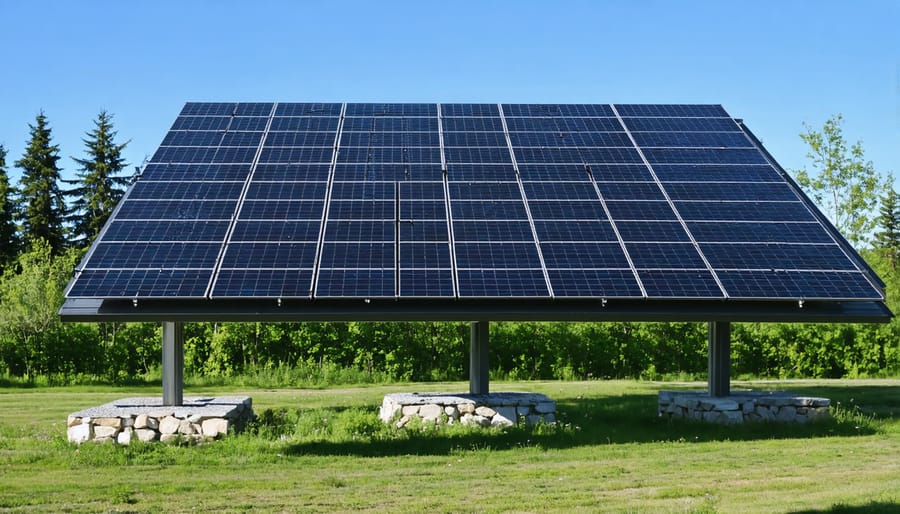
Solar Power: More Than Just Panels on a Roof
Campground Comfort Stations Getting a Sunny Upgrade
Picture this: you’ve just finished a dusty hike and you’re heading to the washroom, only to notice the solar panels gleaming on the roof above. Welcome to Ontario’s new generation of comfort stations!
Algonquin Park leads the pack with their renovated Mew Lake comfort station, featuring a sleek solar array that powers everything from lighting to hand dryers. The facilities stay bright and functional even during peak camping season, and here’s an insider tip – the new setup means consistent water pressure throughout the day, unlike older facilities that struggled during busy periods.
Killbear Provincial Park’s shower house at Lighthouse Point campground is another standout. The solar-heated water system means you’re not just showering with renewable energy – you’re enjoying seriously hot showers without the guilt. Early morning users, take note: the water’s warmest between 10 AM and 4 PM when the panels have had time to work their magic.
Over at Sandbanks Provincial Park, the comfort stations near the day-use area showcase how effective off-grid systems can be. Battery storage keeps everything running after sunset, so late-night bathroom trips are just as well-lit as daytime visits. The motion-sensor lighting is particularly clever, conserving energy while ensuring you’re never fumbling in the dark. These aren’t your grandfather’s outhouses – they’re genuinely comfortable, surprisingly modern spaces that happen to run on sunshine.
Trail Lighting That Doesn’t Need the Grid
Picture this: you’re finishing a gorgeous afternoon hike, but the sun’s setting faster than expected. Instead of fumbling for your phone’s flashlight, you notice subtle solar-powered lights illuminating the trail ahead—just bright enough to guide your steps without washing out the stars overhead.
Many Ontario parks have ditched the traditional approach of running costly electrical lines through pristine wilderness. Instead, they’re installing solar-powered pathway lights that charge during the day and automatically illuminate at dusk. These compact fixtures blend seamlessly into the natural landscape, often mounted on low posts or embedded directly into the trail surface.
**Insider tip**: Conservation areas like Rattray Marsh in Mississauga and sections of the Waterfront Trail use these systems brilliantly. The lighting extends usable hours without the harsh glare that disrupts wildlife or ruins that peaceful evening ambiance you’re seeking.
The best part? These lights require virtually no maintenance and zero ongoing energy costs. Park staff aren’t digging trenches or managing complex electrical systems—they’re simply placing self-contained units where visitors need guidance most. For you, this means safer evening strolls, extended birdwatching opportunities during golden hour, and the confidence to explore without worrying about getting caught in complete darkness.
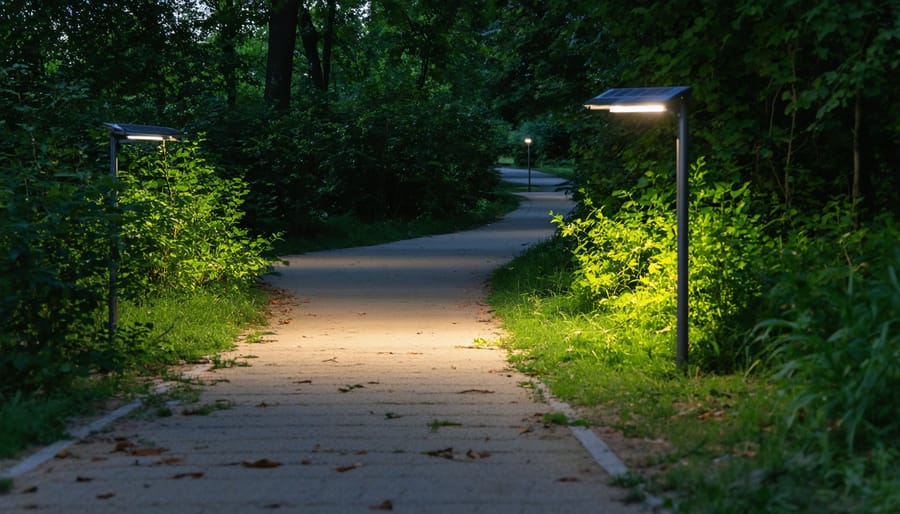
The Charging Stations You Didn’t Know You Needed
Picture this: you’re halfway through a gorgeous trail, your phone’s at 15%, and you’re desperately trying to capture that perfect sunset shot. Enter Ontario’s solar-powered charging stations—your new best friend in the wilderness.
These eco-friendly lifelines are popping up at key spots across the province. Killarney Provincial Park’s visitor center features charging stations powered entirely by rooftop solar panels, perfect for topping up before heading into backcountry. Bruce Peninsula National Park has similar setups at Cyprus Lake, strategically placed near the Grotto trailhead.
**Insider tip**: Arrive early morning when stations are less busy, and bring your own charging cable—most provide USB ports but not cables. Many stations include weather-resistant lockers where you can safely stow your device while you explore nearby short trails.
The Niagara Parks Commission has also installed solar charging benches along the Niagara River Recreation Trail, letting you rest those tired feet while your phone powers up for those inevitable waterfall selfies.
Wind and Water: Ontario’s Other Green Powerhouses
Small-Scale Hydro Projects in Action
Picture this: you’re hiking beside a rushing waterfall, and instead of just admiring the view, you’re actually witnessing clean energy being generated right before your eyes! Several Ontario parks have cleverly harnessed the natural power of flowing water through micro-hydro installations.
These compact systems work beautifully simple – water flows through a small turbine, spinning it to generate electricity without damaging the ecosystem or changing the landscape you came to enjoy. Unlike massive dams, micro-hydro units are typically no bigger than a garden shed and produce just enough power for visitor centers, lighting, and essential facilities.
Algonquin Provincial Park features one of the most accessible examples, where a micro-hydro system near Ragged Falls quietly powers nearby operations. The setup blends so seamlessly into the environment that most visitors walk right past without noticing – which is exactly the point! Frontenac Provincial Park has also explored similar technologies as part of Ontario’s eco-tourism transformation.
**Insider tip:** Ask park staff about guided tours showcasing these installations. Many parks offer educational programs explaining how the systems work, and kids absolutely love seeing renewable energy in action. It’s a fantastic way to understand how your park visit supports environmental conservation while enjoying nature’s power firsthand.
When the Wind Works (And When It Doesn’t)
Wind turbines at Ontario parks are a bit like that friend who shows up to every camping trip with the best intentions but doesn’t always deliver. I’ve watched these elegant giants spin gracefully at places like Rondeau Provincial Park, and I’ve also seen them sitting perfectly still on calm summer days when the visitor centre really needs that air conditioning.
Here’s the truth: wind power works brilliantly in Ontario’s lakeside parks where prevailing breezes are reliable. The turbines at some facilities generate enough electricity to power entire maintenance buildings and lighting systems. But inland locations? That’s where things get tricky. Wind patterns can be unpredictable, and trees create natural barriers that reduce efficiency.
**Insider tip**: Ask park staff about their wind systems during your visit. Many parks now offer informal tours or information sessions, and rangers love sharing real data about their energy production. You’ll learn that most successful installations pair wind with solar panels – a backup plan that keeps facilities running regardless of weather conditions.
The challenge isn’t the technology itself; it’s matching the right renewable solution to each unique location. That’s why you’ll notice not every Ontario park has wind turbines, and that’s actually smart planning rather than a missed opportunity.
The Invisible Infrastructure Making It All Work
Battery Storage: Your Backup When the Sun Sets
Picture this: you’re settling into your campsite at dusk after a perfect day on the trails, and the park’s visitor center lights stay bright even though the solar panels have called it quits for the night. That’s battery storage in action!
Energy storage systems work like giant power banks, collecting sunshine during the day and releasing it when you need it most. For campers, this means hot showers at any hour, well-lit washrooms after dark, and those all-important phone charging stations that keep you connected to emergency services.
Many Ontario parks now use lithium-ion batteries (similar to your phone’s, just way bigger!) to store excess solar energy. Killarney Provincial Park’s visitor facilities, for example, can run entirely off stored solar power through the evening, ensuring amenities stay operational regardless of weather.
**Insider tip**: Parks with battery storage often maintain more consistent water pressure in their facilities since pumps don’t compete with daytime energy demands. Look for the small solar+battery icons on park maps – they indicate which buildings have the most reliable services, especially during your early morning bathroom dash!
Smart Systems That Keep the Lights On
Think of energy management systems as the conductor of an orchestra – they make sure everything works in perfect harmony. When you’re charging your phone at a visitor center or grabbing a cold drink from the café, smart systems are working behind the scenes to keep everything running smoothly.
Here’s the cool part: these systems know when solar panels are generating extra power on sunny days, so they store that energy in batteries for cloudy afternoons or evening hours. They’re constantly balancing what’s being generated, what’s stored, and what’s needed right now. It’s like having a really smart thermostat for an entire park facility!
During your visit, you might notice digital displays showing real-time energy production – many parks now feature these as educational tools. Some facilities even adjust their power-hungry systems (like heating or air conditioning) during peak visitor hours to maximize efficiency without you ever noticing a difference in comfort.
**Insider tip**: Visit interpretive centers during mid-day when solar generation peaks – you’ll often see these systems at their most impressive, and staff are usually excited to explain how everything works!
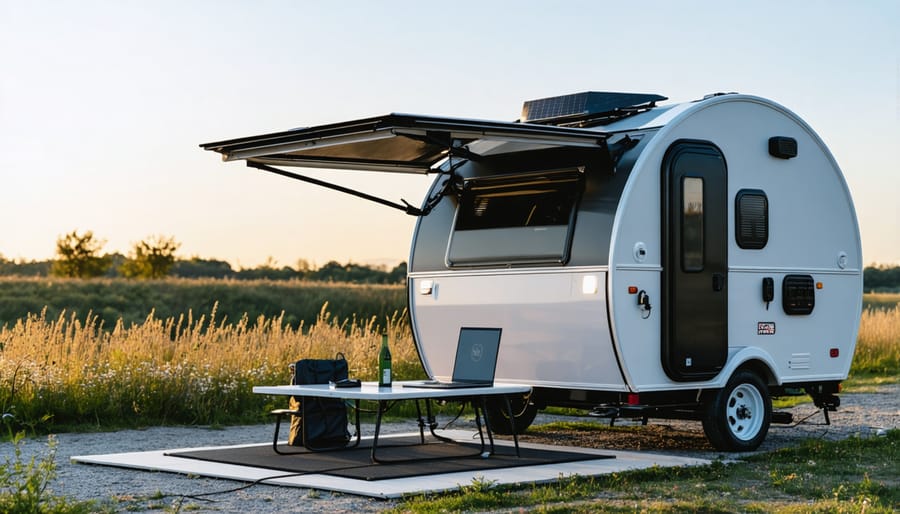
What This Means for Your Next Visit
Facilities That Stay Open Longer
Here’s something I’ve noticed on my recent park visits: facilities that used to close at dusk are now staying open well into the evening. Thanks to solar-powered lighting and battery storage systems, visitor centers, washrooms, and picnic shelters at several Ontario parks maintain extended hours year-round.
This is a game-changer for families with packed schedules or photographers chasing that golden hour light. At Killbear Provincial Park, solar arrays keep the main comfort station operational until 10 PM during summer months—no more racing back to your campsite before dark!
The real insider tip? These renewable-powered facilities often remain operational during shoulder seasons when traditional buildings might close early to save energy costs. I’ve enjoyed perfectly functional heated washrooms at Algonquin Park in late October, all thanks to their hybrid solar and wind systems. It means you can extend your camping season without sacrificing basic comforts, making Ontario’s natural beauty more accessible to everyone.
The Quiet Revolution (Literally)
Remember the days when campground mornings meant waking to the rumble of diesel generators? Those times are fading fast at Ontario’s forward-thinking parks. I’ll never forget my first night at a solar-powered campground near Tobermory—the absence of mechanical noise was so striking, I actually heard owls hunting at 2 AM. It was magical.
Modern renewable energy systems have transformed the camping soundscape. Solar panels and wind turbines operate silently, replacing those jarring generator engines that used to punctuate every outdoor experience. At facilities like Bon Echo Provincial Park, where solar arrays now power amenities, you’ll notice the difference immediately—birdsong replaces motor hum, and nighttime stays truly peaceful.
**Insider tip:** Visit during shoulder seasons (May or September) when renewable-powered parks are quieter still, and you’ll experience nature’s soundtrack without any mechanical interference. It’s camping as it was meant to be—just you, the wilderness, and blessed silence.
Insider Tips: Making the Most of Green-Powered Parks
Pack Smart for Solar-Powered Campgrounds
Planning your earth-friendly camping trip? Here’s an insider tip: bring a power bank and charge it during peak solar hours—typically 10 AM to 2 PM when the sun’s at its strongest. Most solar-powered campgrounds have shared charging stations near main facilities, so grab that prime morning slot while others are out hiking!
Pack a multi-device USB hub to maximize your charging station time, and consider bringing solar-compatible battery packs that work with the campground’s system. Time your laundry and hot showers for sunny afternoons when renewable energy production peaks—you’ll help reduce strain on backup systems while enjoying better water pressure.
Pro tip: Download offline maps and entertainment before arriving, as cloudy days can mean slower charging times. Many campgrounds also offer real-time energy availability boards near ranger stations, so check those first thing to plan your day around available power. Remember, working with nature’s rhythms makes your stay smoother and supports the park’s green initiatives!
Educational Opportunities You Shouldn’t Miss
Many Ontario parks now offer guided tours where you can see their renewable energy systems up close. At several conservation areas, ranger-led programs explain how solar panels and wind turbines power visitor centers and campground facilities. You’ll often spot interpretive displays near these installations, complete with real-time energy output monitors that show exactly how much power is being generated.
**Insider tip:** Visit during shoulder seasons when tour groups are smaller, and staff have more time for your questions. Some parks even offer behind-the-scenes access to their battery storage systems and smart grid controls—perfect for anyone curious about these environmental innovations.
Check park websites before your visit, as many facilities now feature virtual energy dashboards you can explore from home, helping you plan which installations you’d most like to see in person.
So here’s the beautiful truth I’ve discovered through countless park visits: renewable energy infrastructure doesn’t diminish the magic of Ontario’s natural spaces—it actually enhances it. There’s something deeply satisfying about knowing that the hot shower after your canoe trip, or the electricity powering your evening campsite lantern, comes from the sun and wind rather than a diesel generator rumbling in the distance.
These green innovations create quieter, cleaner environments where you can truly disconnect from urban life while still enjoying modern comforts. The solar panels become conversation starters around the campfire, teaching moments for curious kids, and proof that we can explore nature responsibly without leaving heavy footprints behind.
**Insider tip**: Visit during shoulder seasons when you’ll have more time to chat with park staff about these systems—they’re genuinely passionate about sharing how everything works!
I encourage you to experience this evolution firsthand. Book a stay at one of Ontario’s forward-thinking parks and see how seamlessly renewable energy blends into your outdoor adventure. Support these facilities that are pioneering a sustainable future for tourism. Touch a solar panel, notice the absence of generator noise, breathe that clean air, and know you’re part of something bigger—a movement toward preserving these wild spaces for generations to come. Your visit isn’t just a vacation; it’s a vote for sustainable tourism and proof that environmental responsibility and unforgettable experiences go hand in hand.

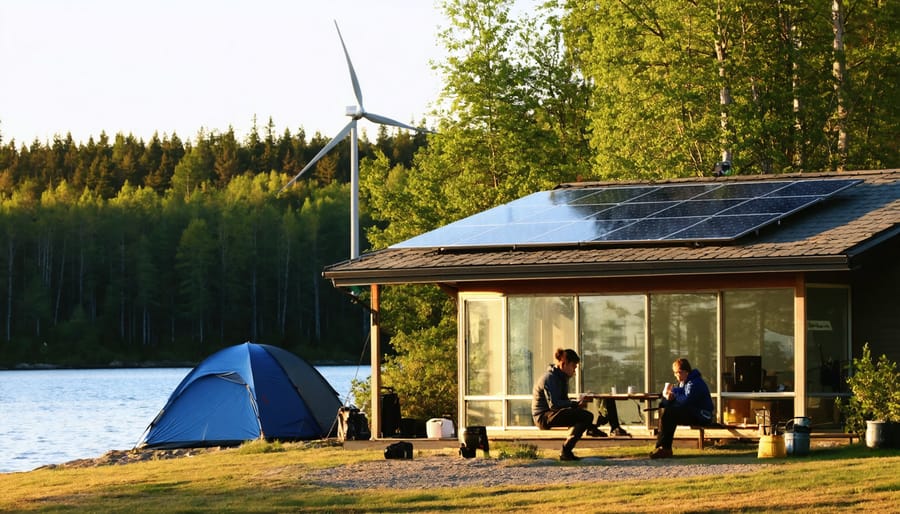







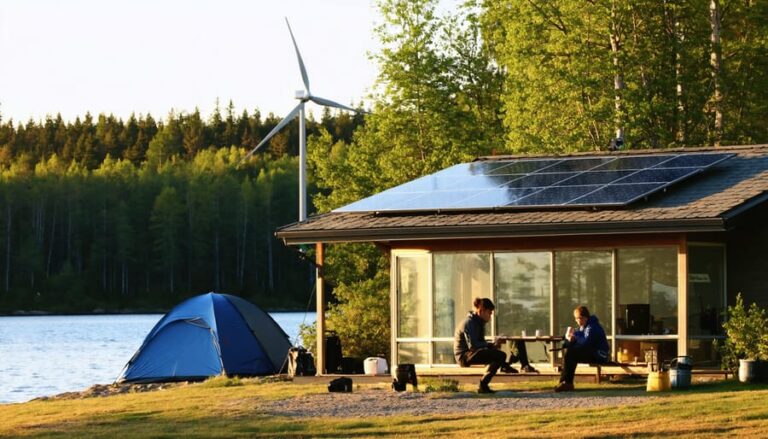




+ There are no comments
Add yours